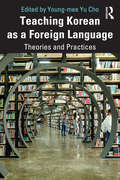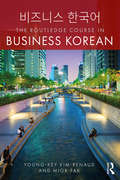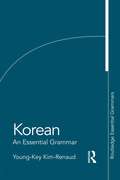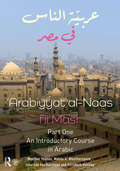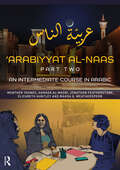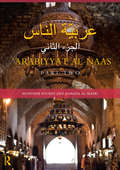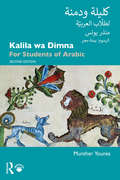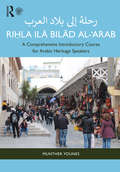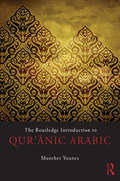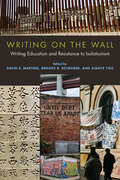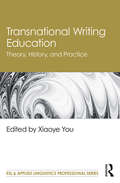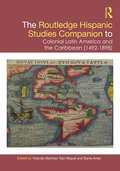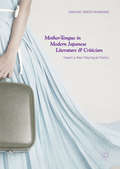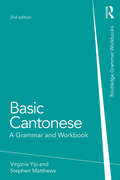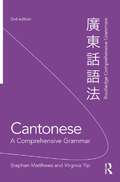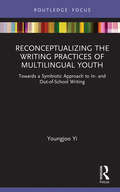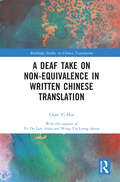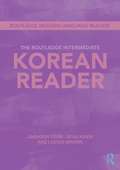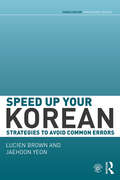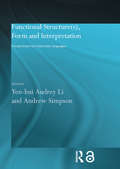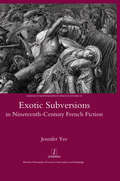- Table View
- List View
Teaching Korean as a Foreign Language: Theories and Practices
by Young-mee Yu ChoTeaching Korean as a Foreign Language: Theories and Practices is designed for prospective or in-service Korean as a Foreign Language (KFL) teachers. With contributions from leading experts in the field, readers will gain an understanding of the theoretical framework and practical applications of KFL education in the context of Second Language Acquisition (SLA). The eight chapters explore the history of and current issues in language education, the practicalities of being a classroom teacher, and teaching and evaluation techniques for developing language and cultural proficiency. This comprehensive volume also includes an annotated bibliography which lists over 500 of the most recent and pertinent research articles and doctoral dissertations in the area. This bibliography will be of great service to students, teachers, and any researchers in applied linguistics and second language acquisition interested in Korean language education.
The Routledge Course in Business Korean
by Young-Key Kim-Renaud Miok PakThe Routledge Course in Business Korean is a textbook to teach Korean to mid-intermediate to low-advanced students learning the language used in a business context in every-day life in Korea. The authors’ intuitive approach makes it easy for students to follow the units, while the relevant and practical learning objectives benefit both student and teacher alike. The book introduces the vocabulary and key phrases of Business Korean and focuses on delivering real business-related situations, authentic expressions, and linguistically and culturally rich introductions and explanations of Korean business life. Audio files can be found on the accompanying e-Resource. By the end of this course, you will be at level B2 of the Common European Framework for Languages and Advanced Mid-High on the ACTFL proficiency scales.
Korean: An Essential Grammar (Routledge Essential Grammars)
by Young-Key Kim-RenaudKorean: An Essential Grammar is a concise and convenient guide to the basic grammatical structure of standard Korean. Presenting a fresh and accessible description of the language, this engaging Grammar uses clear, jargon-free explanations and sets out the complexities of Korean in short, readable sections. Key features include: clear explanations of grammatical terms frequent use of authentic examples the Korean alphabet used alongside McCune-Reischauer romanization system a full glossary of explanations.
Arabiyyat al-Naas fii MaSr (Part One): An Introductory Course in Arabic
by Munther Younes Makda Weatherspoon Elizabeth Huntley Jonathan Featherstone‘Arabiyyat al-Naas fii MaSr (Part One) offers a ground-breaking introduction to Arabic as it is written and spoken by native speakers. It combines a progressive and rigorous grounding in Modern Standard Arabic (MSA), the register employed for reading, writing and formal speaking, with an innovative integration of the dominant Egyptian variety. Introducing the two simultaneously and seamlessly building on their shared features, ‘Arabiyyat al-Naas fii MaSr (Part One) uses each in its proper context: Egyptian dialect for conversations and MSA for reading and writing activities. In this way, the course efficiently prepares students for the practical realities of learning and living Arabic today. Features include: Expanded grammar explanations and activation drills, including discussions about colloquial and formal similarities and differences A series of authentic video-clips recorded in Egypt to help learners revise the vocabulary and structures then learn unit by unit Extensive classroom activities and homework exercises that provide constant review to reinforce learning Arabic-English and English-Arabic glossaries, reference charts, and a grammar index Songs with simple lyrics tied to the themes of the course to help advance vocabulary acquisition and understanding of basic grammatical structures A companion website (www.routledge.com/cw/weatherspoon) that features fully integrated interactive, self-correcting exercises, audio and video materials, and additional online course management and grading options for teachers A user-friendly and vibrant text design with full colour, richly illustrated throughout with over two hundred illustrations and photos A teachers manual with an Arabic introduction for the teacher, which lays out the structure of the student course book, its methodology and directions and suggestions for its use. Written by experienced teachers of Arabic and experts in Arabic teaching pedagogy, ‘Arabiyyat al-Naas fii MaSr (Part One) is an essential resource for students beginning to learn Arabic.
'Arabiyyat al-Naas (Part Two): An Intermediate Course in Arabic
by Munther Younes Hanada Al-Masri Jonathan Featherstone Elizabeth Huntley Makda Weatherspoon‘Arabiyyat al-Naas (Part Two) is an Arabic language textbook designed to bring learners from a lower to a higher intermediate level of language proficiency. Using the Common European Framework Reference, it takes the learner from B.1 to B.2 and, in terms of the levels of the American Council on the Teaching of Foreign Languages, it takes the learner from Intermediate Low to Intermediate High/Advanced Low. The book is a continuation of the first level books in this series (either Arabiyyat al-Naas fii Bilaad al-Shaam or Arabiyaat al-Naas fii maSr ) and follows the Integrated Approach to Arabic instruction. It is a theme-based textbook delivered in the form of a serialized radio drama. Through the lens of journalism and personal interactions modelled by the main characters of this radio drama, learners are equipped to continue developing their spoken and written Arabic skills in the context of authentic dialogues and reading texts. As such, this book reflects cross-dialectal communication as used by native speakers across the Arab world.
'Arabiyyat al-Naas (Part Two): An Intermediate Course in Arabic
by Munther Younes Hanada Al-Masri Jonathan Featherstone Elizabeth Huntley Makda WeatherspoonArabiyyat al Naas (Part Two): An Intermediate Course in Arabic, second edition, offers a vibrant course in Arabic as it is written and spoken today by educated native speakers. It is a theme-based textbook delivered in the form of a serialized radio drama. Through the lens of journalism and personal interactions modelled by the main characters of this radio drama, learners are equipped to continue developing their spoken and written Arabic skills in the context of authentic dialogues and reading texts. As such, this book reflects cross-dialectal communication as used by native speakers across the Arab world.Features include: Twenty-one theme-based units covering a wide range of relevant and engaging topics Thorough coverage of listening, speaking, writing and reading skills in every unit, with lessons structured to provide students with variety, stimulation and further opportunities for practice Humorous, realistic dialogues reflecting everyday educated speech among Arabs to build up strong and practical communication skills Free companion website (www.routledge.com/cw/younes) featuring extensive audio recordings of the listening materials in the textbook, videos that supplement the textbook, and texts of the listening passages in the textbook Developed by an experienced and dynamic author team and tested over a number of years at Cornell University, Arabiyyat al Naas (Part Two) will be an essential resource for intermediate-level students of Arabic. While primarily designed for classroom use, the accessibility of the course also renders it highly suitable for independent study. Using the Common European Framework Reference, it takes the learner from B.1 to B.2 and, in terms of the levels of the American Council on the Teaching of Foreign Languages, it takes the learner from Intermediate Low to Intermediate High/Advanced Low.This volume is the second in a pioneering three-part series of Arabic textbooks which together provide a complete three-year undergraduate language program.
Arabiyyat al-Naas (Part Two): An Intermediate Course in Arabic
by Munther Younes Hanada Al-MasriArabiyyat al Naas (Part Two): An Intermediate Course in Arabic offers a vibrant course in Arabic as it is written and spoken today by educated native speakers. Not only does it continue the innovative integration of Modern Standard Arabic (MSA) and Levantine Arabic used in Part One of the series, but it does so in a way that supports and develops students’ increased mastery of the language. Combining a greater focus on cultural topics with an increased coverage of MSA, Part Two introduces more sophisticated communication, giving students a deeper awareness of the cultural base of the Arabic language. Features include: Twenty-one theme-based units covering a wide range of relevant and engaging topics, including education and learning, jobs and professions, the Arab woman, religion, money and the economy, politics and government and the environment Thorough coverage of listening, speaking, writing and reading skills in every unit, with lessons structured to provide students with variety, stimulation and further opportunities for practice Humorous, realistic dialogues reflecting everyday educated speech among Arabs to build up strong and practical communication skills A rich variety of reading passages, including poems, short stories, newspaper articles, descriptions of Arab cities and biographies of famous figures, designed to improve comprehension and analytical skills and to deepen students’ knowledge of Arab history, culture, language, and literature An extensive range of appealing exercises and activities, including crossword puzzles, root-and-pattern identification exercises, passage completions, guided and free compositions, and songs Free accompanying CD that includes audio recordings of the listening materials in the 21 units and a number of songs tied to their themes Free companion website (www.routledge.com/cw/younes) featuring the texts of the listening passages, the audio recordings available on the CD , a track list of all the audio materials, the answer keys to the crossword puzzles, sample tests and language games. Developed by an experienced and dynamic author team and tested over a number of years at Cornell University, Arabiyyat al Naas (Part Two) will be an essential resource for intermediate-level students of Arabic. While primarily designed for classroom use, the accessibility of the course also renders it highly suitable for independent study. This volume is the second in a pioneering three-part series of Arabic textbooks which together provide a complete three-year undergraduate language program.
Kalila wa Dimna: For Students of Arabic
by Munther YounesSpecifically designed for students of Arabic, this fully illustrated rendition of the Arabic literary classic enhances students’ reading, listening, speaking, and writing skills through the medium of these fun, engaging, and culturally relevant tales. The first part of this second edition follows the original order of the stories, with new vocabulary explained in footnotes throughout. In the second part, grammar explanations and a wealth of exercises provide ample opportunities for readers to improve their understanding of the stories and strengthen their command of Arabic grammar and Arabic writing. The audio material, containing the texts of the stories read by native speakers, is available to download free online to help develop the learner’s listening skills. Suitable for both class use and independent study, Kalila wa Dimna: for Students of Arabic is a must for all intermediate to advanced students wishing to enhance their language skills and discover one of the most popular pieces of Arabic literature ever written.
Riḥla ilā Bilād al-‘Arab رحلة إلى بلاد العرب: A Comprehensive Introductory Course for Arabic Heritage Speakers
by Munther YounesRiḥla ilā Bilād al-‘Arab starts with the Arabic alphabet and gradually and systematically builds the reading and writing skills and mastery of Fuṣḥā grammar. As students develop their reading, writing, and grammar skills, they will be learning about Arab history, society, and culture. This book contextualizes Arabic grammar teaching with sufficient and relevant drills and exercises. Added personal and cultural interest is given by the diary of Amal, an American student of Arab descent, who travels to Jordan and Palestine. This textbook includes maps, illustrations, and photographs and is accompanied by audio on the companion website that can be viewed here: www.routledge.com/cw/younes . The book is designed for Arabic heritage students—students who can understand and speak an Arabic dialect (Egyptian, Iraqi, Moroccan, etc.) but are unfamiliar with Modern Standard Arabic, known as Fuṣḥā.
The Routledge Introduction to Qur'anic Arabic
by Munther YounesThe Routledge Introduction to Qur’ānic Arabic is an innovative, text-based, language course designed for students interested in acquiring a foundation in Qur’ānic and Classical Arabic. Focused on enhancing comprehension and vocabulary acquisition, the book contains 40 lessons designed to be covered in about 40 hours of classroom instruction. Starting with the shorter sūras of the Qur’ān, such as al-Fatiha and those of the Juz’ ‘Amma, it utilizes their recurring vocabulary and grammatical structures to build a stable linguistic foundation for learners before moving on to more challenging and longer sūras such as Yāsīn, Maryam and Yūsuf. Although the book is primarily designed for classroom use, the vocabulary and structures of the short sūras, the accompanying audio recordings, and the activities found throughout the book will also be helpful for independent learners. The only prerequisite is knowledge of the Arabic writing system. The audio material, which is available on the Routledge website, helps learners improve their pronunciation of individual sounds and develop their skills to syllabify Arabic words and phrases correctly in order to approximate that of native speakers. Also available on the website are answer keys to exercises and transcriptions of the audio material. Written by an experienced teacher, The Routledge Introduction to Qur’ānic Arabic is an essential guide for instructors, students and anyone interested in developing their knowledge of Qur’ānic Arabic.
Writing on the Wall: Writing Education and Resistance to Isolationism
by Xiaoye You David S. Martins Brooke R. SchreiberThe first concerted effort of writing studies scholars to interrogate isolationism in the United States, Writing on the Wall reveals how writing teachers—often working directly with students who are immigrants, undocumented, first-generation, international, and students of color—embody ideas that counter isolationism. The collection extends existing scholarship and research about the ways racist and colonial rhetorics impact writing education; the impact of translingual, transnational, and cosmopolitan ideologies on student learning and student writing; and the role international educational partnerships play in pushing back against isolationist ideologies. Established and early-career scholars who work in a broad range of institutional contexts highlight the historical connections among monolingualism, racism, and white nationalism and introduce community- and classroom-based practices that writing teachers use to resist isolationist beliefs and tendencies. “Writing on the wall” serves as a metaphor for the creative, direct action writing education can provide and invokes border spaces as sites of identity expression, belonging, and resistance. The book connects transnational writing education with the fight for racial justice in the US and around the world and will be of significance to secondary and postsecondary writing teachers and graduate students in English, linguistics, composition, and literacy studies. Contributors: Olga Aksakalova, Sara P. Alvarez, Brody Bluemel, Tuli Chatterji, Keith Gilyard, Joleen Hanson, Florianne Jimenez Perzan, Rebecca Lorimer Leonard, Layli Maria Miron, Tony D. Scott, Kate Vieira, Amy J. Wan
Transnational Writing Education: Theory, History, and Practice (ESL & Applied Linguistics Professional Series)
by Xiaoye YouArguing that writing teachers need to enable students to recognize, negotiate with, deconstruct, and transcend national, racial, ethnic, and linguistic boundaries, this volume proposes a "transnational" framework as an alternative approach to literacy education and as a vital component to cultivating students as global citizens. In a field of evolving literacy practices, this volume builds off the three pillars of transnational writing education—translingualism, transculturalism, and cosmopolitanism—and offers both conceptual and practice-based support for scholars, students, and educators in order to address current issues of inclusion, multilingual learning, and diversity.
The Routledge Hispanic Studies Companion to Colonial Latin America and the Caribbean (Routledge Companions to Hispanic and Latin American Studies)
by Yolanda Martínez-San Miguel Santa AriasThe Routledge Hispanic Studies Companion to Colonial Latin America and the Caribbean (1492-1898) brings together an international team of scholars to explore new interdisciplinary and comparative approaches for the study of colonialism. Using four overarching themes, the volume examines a wide array of critical issues, key texts, and figures that demonstrate the significance of Colonial Latin America and the Caribbean across national and regional traditions and historical periods. This invaluable resource will be of interest to students and scholars of Spanish and Latin American studies examining colonial Caribbean and Latin America at the intersection of cultural and historical studies; transatlantic, postcolonial and decolonial studies; and critical approaches to archives and materiality. This timely volume assesses the impact and legacy of colonialism and coloniality.
Mother-Tongue in Modern Japanese Literature and Criticism: Toward a New Polylingual Poetics
by Takayuki Yokota-MurakamiThis book examines how early research on literary activities outside national literatures such as émigré literature or diasporic literature conceived of the loss of ‘mother-tongue” as a tragedy, and how it perpetuated the ideology of national language by relying on the dichotomy of native language/foreign language. It transcends these limitations by examining modern Japanese literature and literary criticism through modern philology, the vernacularization movement, and Korean-Japanese literature. Through the insights of recent philosophical/linguistic theories, it reveals the political problems of the notion of “mother-tongue” in literary and linguistic theories and proposes strategies to realize genuinely “exophonic” and “translational” literature beyond the confines of nation. Examining the notion of “mother-tongue” in literature and literary criticism, the author deconstructs the concept and language itself as an apparatus of nation-state in order to imagine alternative literature, genuinely creolized and heterogeneous. Offering a comparative, transnational perspective on the significance of the mother tongue in contemporary literatures, this is a key read for students of modern Japanese literature, language and culture, as well as those interested in theories of translation and bilingualism.
Basic Cantonese: A Grammar and Workbook (Grammar Workbooks)
by Virginia Yip Stephen MatthewsBasic Cantonese introduces the essentials of Cantonese grammar in a straightforward and systematic way. Each of the 28 units deals with a grammatical topic and provides associated exercises, designed to put grammar into a communicative context. Special attention is paid to topics which differ from English and European language structures. This new edition features: • clear, accessible format • lively examples to illustrate each grammar point • informative keys to all exercises • glossary of grammatical terms Basic Cantonese is ideal for students new to the language. Together with its sister volume, Intermediate Cantonese, it forms a structured course of the essentials of Cantonese grammar.
The Bilingual Child
by Virginia Yip Stephen MatthewsHow does a child become bilingual? The answer to this intriguing question remains largely a mystery, not least because it has been far less extensively researched than the process of mastering a first language. Drawing on new studies of children exposed to two languages from birth (English and Cantonese), this book demonstrates how childhood bilingualism develops naturally in response to the two languages in the children's environment. While each bilingual child's profile is unique, the children studied are shown to develop quite differently from monolingual children. The authors demonstrate significant interactions between the children's developing grammars, as well as the important role played by language dominance in their bilingual development. Based on original research and using findings from the largest available multimedia bilingual corpus, the book will be welcomed by students and scholars working in child language acquisition, bilingualism and language contact.
The Bilingual Child
by Virginia Yip Stephen MatthewsHow does a child become bilingual? The answer to this intriguing question remains largely a mystery, not least because it has been far less extensively researched than the process of mastering a first language. Drawing on new studies of children exposed to two languages from birth (English and Cantonese), this book demonstrates how childhood bilingualism develops naturally in response to the two languages in the children's environment. While each bilingual child's profile is unique, the children studied are shown to develop quite differently from monolingual children. The authors demonstrate significant interactions between the children's developing grammars, as well as the important role played by language dominance in their bilingual development. Based on original research and using findings from the largest available multimedia bilingual corpus, the book will be welcomed by students and scholars working in child language acquisition, bilingualism and language contact.
The Bilingual Child
by Virginia Yip Stephen MatthewsHow does a child become bilingual? The answer to this intriguing question remains largely a mystery, not least because it has been far less extensively researched than the process of mastering a first language. Drawing on new studies of children exposed to two languages from birth (English and Cantonese), this book demonstrates how childhood bilingualism develops naturally in response to the two languages in the children's environment. While each bilingual child's profile is unique, the children studied are shown to develop quite differently from monolingual children. The authors demonstrate significant interactions between the children's developing grammars, as well as the important role played by language dominance in their bilingual development. Based on original research and using findings from the largest available multimedia bilingual corpus, the book will be welcomed by students and scholars working in child language acquisition, bilingualism and language contact.
Cantonese: A Comprehensive Grammar (Grammar Workbooks Ser.)
by Virginia Yip Stephen MatthewsCantonese: A Comprehensive Grammar is a complete reference guide to Cantonese as spoken by native speakers in Hong Kong. It presents a fresh and accessible description of the language, concentrating on the real patterns of use in current Cantonese. This makes it the ideal reference source for all learners and users of Cantonese, irrespective of level, in schools, colleges, universities and adult classes of all types. Moreover, it will provide a lasting and reliable resource for all fluent speakers of the language. The book is organized to promote a thorough understanding of Cantonese grammar. Arranged by both syntactic categories and language functions, the Grammar provides an in-depth treatment of structures and pays special attention to idiom and speech registers. Explanations are full, clear and free of jargon. An extensive index, numbered paragraphs and generous use of headings and cross-references provide readers with easy access to the information they require. Features include: Comprehensive pronunciation section Full use of examples from films, advertising and authentic conversations Cantonese-English parallels highlighted throughout the book All examples given in characters as well as pinyin
Reconceptualizing the Writing Practices of Multilingual Youth: Towards a Symbiotic Approach to In- and Out-of-School Writing (Routledge Research in Literacy Education)
by Youngjoo YiFocusing on adolescent multilingual writing, this text problematizes the traditional boundaries between academic writing in school contexts and self-initiated writing outside of the formal learning environment. By reconceptualizing the nature of adolescent multilingual writing, the author establishes it as an interdisciplinary genre and a key area of inquiry for research and pedagogy. Organized into six chapters, Reconceptualizing the Writing Practices of Multilingual Youth provides an in-depth examination of the writing practices of multilingual youth from sociocultural and social practice perspectives. Drawing on first-hand research conducted with young people, the text questions the traditional dichotomy between academic writing and non-formal equivalents and proposes a symbiotic approach to exploring and cultivating the connections between in- and out-of-school literate lives. By highlighting a bidirectional relationship between formal and informal writing, the text advocates for writing instruction that helps adolescents use writing for entertainment, identity construction, creative expression, personal well-being, and civic engagement, as well as helps them learn to navigate future literacies that we cannot imagine or predict now. This much-needed text will provide researchers and graduate students with a principled overview and synthesis of adolescent multilingual writing research that is significant yet underexplored in applied linguistics, TESOL, and literacy studies.
A Deaf Take on Non-Equivalence in Written Chinese Translation (Routledge Studies in Chinese Translation)
by Chan Yi HinA Deaf Take on Non-Equivalence in Written Chinese Translation examines the issue of lexical non-equivalence between written Chinese and Hong Kong Sign Language (HKSL) translation, describing its theoretical and practical implications. This research foregrounds the semiotic resources in the Deaf community of Hong Kong by analyzing translation strategies exhibited by Deaf Hongkongers when they were invited to translate written Chinese passages with specialized and culturally specific concepts in a monologic setting. With discourse analysis as a framework, the major findings of this research were that: (1) a taxonomy of strategies featured depiction, manual representations of Chinese characters and visual metonymy, writing and mouthing; (2) employment of multisemiotic and multimodal resources gave intended viewers access to different facets of meaning; and (3) repeated renditions of the same concepts gave rise to condensed, abbreviated occasionalisms. Observations from this research serve as a point of reference for interpreting scholars, practitioners and students as well as policymakers who formulate interpretation service provision and assessment.
The Routlege Intermediate Korean Reader
by Jaehoon Yeon Jieun Kiaer Lucien BrownThe Routledge Intermediate Korean Reader is a comprehensive reader designed to provide varied, stimulating and up-to-date reading material for learners of Korean at the intermediate level. The Korean Reader provides a bridge between basic literacy skills and the ability to read full novels and newspapers in Korean. It consists of eighteen readings, graded on the basis of complexity of vocabulary, grammar and syntax. These readings present a range of different text types representative of modern Korean literary and popular writing which will inspire learners to continue reading independently in Korean. It is ideal for learners who already possess knowledge of essential grammar and vocabulary and who wish to expand their knowledge of the language through contextualized reading material. Key features include: extracts of modern literature and newspaper/magazine articles vocabulary lists for quick reference short grammar explanations of any complicated structures comprehension and discussion questions full answer key at the back. Suitable for both class use and independent study, The Routledge Intermediate Korean Reader is an essential tool for facilitating vocabulary learning and increasing reading proficiency. The Reader is ideal for learners at the intermediate-mid or intermediate high who are aiming to achieve advanced proficiency according to the ACTFL proficiency guidelines. In terms of the Common European Framework this equates to a progression from A2 through to B1/B2.
Speed up your Korean: Strategies to Avoid Common Errors
by Jaehoon Yeon Lucien BrownWord order, honorifics, terms of addresses and idiomatic expressions are just some of the areas that cause confusion for students of Korean. Learning how to avoid the common errors that arise repeatedly in these areas is an essential step in successful language learning. Speed Up Your Korean is a unique and innovative resource that identifies and explains these errors, enabling students to learn from their mistakes while enhancing their understanding of the Korean language. Key features: Carefully selected grammar topics and examples based on the most commonly made errors Comprehensive explanations of the most difficult grammar points help learners gain an in-depth understanding of Korean grammar and usage. Exercises throughout reinforce learning and link theory to practice Suitable both for classroom use or self-study, Speed Up Your Korean is the ideal resource for all intermediate learners of Korean wishing to refine their language skills.
Functional Structure: Perspectives from East Asian Languages (Routledge Studies in Asian Linguistics)
by Yen-hui Audrey Li Andrew SimpsonThe issue of how interpretation results from the form and type of syntactic structures present in language is one which is central and hotly debated in both theoretical and descriptive linguistics.This volume brings together a series of eleven new cutting-edge essays by leading experts in East Asian languages which shows how the study of formal structures and functional morphemes in Chinese, Japanese and Korean adds much to our general understanding of the close connections between form and interpretation. This specially commissioned collection will be of interest to linguists of all backgrounds working in the general area of syntax and language change, as well as those with a special interest in Chinese, Japanese and Korean.
Exotic Subversions in Nineteenth-century French Fiction
by Jennifer YeeIn the course of the nineteenth century France built up a colonial empire second only to Britain's. The literary tradition in which it dealt with its colonial 'Other' is frequently understood in terms of Edward Said's description of Orientalism as both a Western projection and a 'will to govern' over the Orient. There is, however, a body of works that eludes such a simple categorisation, offering glimpses of colonial resistance, of a critique of imperialist hegemony, or of a blurring of the boundaries between the Self and the Other. Some of the ways in which the imperialist enterprise is subverted in the metropolitan literature of this period are examined in this volume through detailed case studies of key works by Chateaubriand, Hugo, Flaubert and Segalen.
